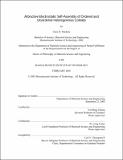| dc.contributor.advisor | Yet-Ming Chiang and W. Craig Carter. | en_US |
| dc.contributor.author | Maskaly, Garry R. (Garry Russell), 1978- | en_US |
| dc.contributor.other | Massachusetts Institute of Technology. Dept. of Materials Science and Engineering. | en_US |
| dc.date.accessioned | 2005-05-17T14:59:43Z | |
| dc.date.available | 2005-05-17T14:59:43Z | |
| dc.date.copyright | 2005 | en_US |
| dc.date.issued | 2005 | en_US |
| dc.identifier.uri | http://hdl.handle.net/1721.1/16704 | |
| dc.description | Thesis (Ph. D.)--Massachusetts Institute of Technology, Dept. of Materials Science and Engineering, 2005. | en_US |
| dc.description | Includes bibliographical references (p. 187-193). | en_US |
| dc.description | This electronic version was submitted by the student author. The certified thesis is available in the Institute Archives and Special Collections. | en_US |
| dc.description.abstract | Ionic colloidal crystals are here defined as multicomponent ordered colloidal structures stabilized by attractive electrostatic interactions. These crystals are colloidal analogues to ionic materials including zincblende, rocksalt, cesium chloride, and fluorite. A thermodynamic study revealed that the screening ratio, charge ratio, and monodispersity are critical parameters in ionic colloidal crystal (ICC) formation. Experimentally, small ordered regions were observed under ideal thermodynamic conditions. However, no larger crystalline regions were found in these samples. The kinetics of ICC formation was studied using a variety of computational techniques, including Brownian dynamics, Monte Carlo, and a Newton's method solver. These techniques have each elucidated properties and processing conditions that are important to crystallization. The Brownian dynamics and Monte Carlo simulations showed that the previous experiments were highly undercooled. Furthermore, a narrow crystallization window was found, demonstrating the need to create particle systems that meet the narrow parameter space where ICCs should be stable. Pair interaction potentials were evaluated for their accuracy using a Poisson-Boltzmann (PB) equation solver. The PB solver was also used to further refine crystalline formation energies so that systems can be more accurately tailored. A surprising result from the PB solver showed that the lowest formation energy occurs when the quantity of surface charges on both particles are equal. Although this result is not predicted by any colloidal pair potentials, it was verified experimentally. This further illustrates that thermal mobility in these systems can be sufficient to maintain a stable solution despite attractive electrostatic interactions. Tailoring particle systems to balance the thermal and electrostatic interactions should allow widespread crystallization. However, these conditions require highly monodisperse particles to be fabricated with controlled surface charge and sizes. Currently these particles are not widely available and further research in this area should aid in the full realization of the ICC concept. In conclusion, all results are integrated to predict which particle systems should be produced to allow the formation of large ordered structures. | en_US |
| dc.description.statementofresponsibility | by Garry R. Maskaly. | en_US |
| dc.format.extent | 193 p. | en_US |
| dc.format.extent | 7064851 bytes | |
| dc.format.extent | 7064543 bytes | |
| dc.format.mimetype | application/pdf | |
| dc.format.mimetype | application/pdf | |
| dc.language.iso | eng | en_US |
| dc.publisher | Massachusetts Institute of Technology | en_US |
| dc.rights | M.I.T. theses are protected by copyright. They may be viewed from this source for any purpose, but reproduction or distribution in any format is prohibited without written permission. See provided URL for inquiries about permission. | en_US |
| dc.rights.uri | http://dspace.mit.edu/handle/1721.1/7582 | |
| dc.subject | Materials Science and Engineering. | en_US |
| dc.title | Attractive electrostatic self-assembly of ordered and disordered heterogeneous colloids | en_US |
| dc.type | Thesis | en_US |
| dc.description.degree | Ph.D. | en_US |
| dc.contributor.department | Massachusetts Institute of Technology. Department of Materials Science and Engineering | |
| dc.identifier.oclc | 58835126 | en_US |
